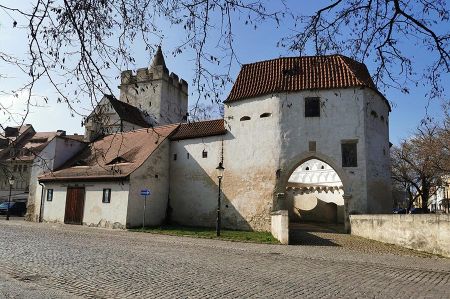The Marientor in Naumburg – a structurally rare barbican
- Written by Portal Editor
We were out and about in Naumburg again, first strolling through the historic old town and then along the Marienmauer to the Marientor, the only remaining city gate of Naumburg's city fortifications, which used to have five gates.
Already during the Saxon Civil War, Naumburg's city gates had been strengthened and as a result, in 1446, the Marientor was given a double-gate, kennel-like complex, a so-called barbican, which today represents a very rarely preserved structure in the history of the preservation of medieval city fortifications.
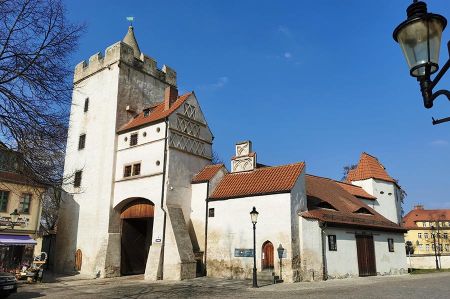 The barbican is a defensive structure in the form of a round or square bastion in front of the gate of a late medieval or Renaissance castle or city wall. The round design, in the classic building style, served as a cannon bastion with no preferred direction for aiming the freely positioned cannons there. The barbicans originate from an attempt to respond to firearms in the second half of the 15th century by building additional defensive and protective structures that were easily defensible in front of the gates. Later, the so-called Raveline were used in a similar function.
The barbican is a defensive structure in the form of a round or square bastion in front of the gate of a late medieval or Renaissance castle or city wall. The round design, in the classic building style, served as a cannon bastion with no preferred direction for aiming the freely positioned cannons there. The barbicans originate from an attempt to respond to firearms in the second half of the 15th century by building additional defensive and protective structures that were easily defensible in front of the gates. Later, the so-called Raveline were used in a similar function.
Some events in the history of Naumburg
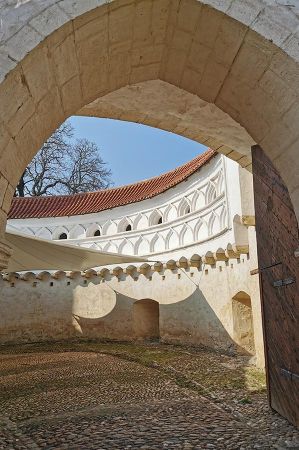 Naumburg developed into a city since the 11th century and a city fortification was first mentioned in the city's annals in 1287.
Naumburg developed into a city since the 11th century and a city fortification was first mentioned in the city's annals in 1287.
The city gate is located in the northeast of Naumburg's old town, where Marienmauer, Postring and Marienstrasse meet, diagonally opposite today's main post office and / or the tram depot.
Between 1456 and 1458, the Marientor was profoundly redesigned by the master builder Valentin Weise, renovated in 1511 and a stone moat bridge was added in 1531.
A further restoration took place in 1704. The defensive wall on the west side has arrow slits. Since the battlement also offers options for shooting inwards, the inner area is a so-called catch yard.
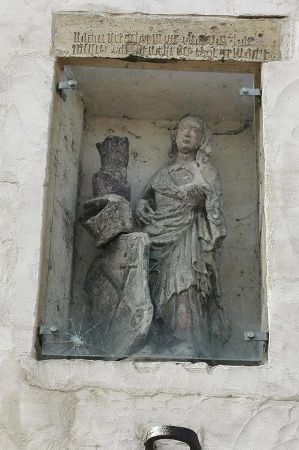 The name Fanghof came from because they wanted to prevent the attackers from getting into the city quickly. When an enemy attacked and broke through the first gate after storming the courtyard, the attackers could be prevented from leaving the courtyard after being shot at with a portcullis. This meant that it could continue to be defended within the gate system. The square tower in the southwest of the gate complex has a conical roof and battlements.
The name Fanghof came from because they wanted to prevent the attackers from getting into the city quickly. When an enemy attacked and broke through the first gate after storming the courtyard, the attackers could be prevented from leaving the courtyard after being shot at with a portcullis. This meant that it could continue to be defended within the gate system. The square tower in the southwest of the gate complex has a conical roof and battlements.
The diverse appearance is explained by different windows and gates (some Gothic pointed arches, some flat arches), brick elements (keel arches, cross arch panels), the city-side gable with diamond panels, bat and drag dormers, parts of the building of different sizes as well as the city coat of arms, an inscription plaque and a figural niche with a figure of the Virgin Mary by Peter Hummelshain (Naumburg) from 1456, which was later supplemented by a wooden boy.
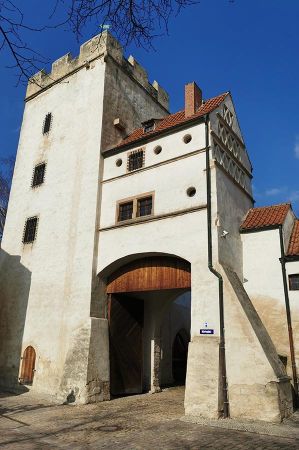 The outer and inner gates enclose the courtyard, which is surrounded by a late Gothic-decorated battlement. The outer gate was installed at a 90-degree angle to the path. The reason is that the gate could not be attacked (rammed) directly. If the penetration did occur, the attackers would then have to penetrate the inner gate. In such an attempt, the attackers in the catch yard could still be fought from the battlements and the square four-story gate adjacent to the inner gate.
The outer and inner gates enclose the courtyard, which is surrounded by a late Gothic-decorated battlement. The outer gate was installed at a 90-degree angle to the path. The reason is that the gate could not be attacked (rammed) directly. If the penetration did occur, the attackers would then have to penetrate the inner gate. In such an attempt, the attackers in the catch yard could still be fought from the battlements and the square four-story gate adjacent to the inner gate.
Later use and today's Marientor Museum
The facility, which was also used as a prison between the 16th and 19th centuries, was extensively renovated between 1997 and 2000. It is a listed building as a listed building. In the interior of the gate building there is an exhibition on the history of Naumburg's city fortifications, and you can also climb the tower. Both can be visited from the end of March to the beginning of November. It also serves as a backdrop for open-air events. The Marientor also functions as a puppet theatre for the Theater Naumburg.
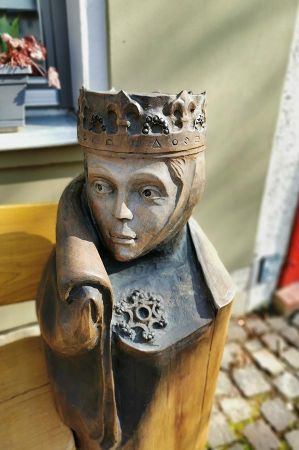 In summer, open-air events take place in the inner courtyard and in front of the backdrop of the Marientor on Marienplatz (Midsummer Night, "Nine Naumburg Nights", summer theatre, open-air cinema, end of summer at Marientor).
In summer, open-air events take place in the inner courtyard and in front of the backdrop of the Marientor on Marienplatz (Midsummer Night, "Nine Naumburg Nights", summer theatre, open-air cinema, end of summer at Marientor).
We recommend visiting the battlement and the interior of the former defence tower, where the gatekeepers and guards lived and which also served as a prison from the 16th to the 19th century. After the complex renovation of the Marientor was completed (1997-2000), an informative permanent exhibition was set up here.
opening hours: April to November 6th - daily: 10 a.m. - 4:30 p.m
Contact: City Museum ''Hohe Lilie'' - Telephone: 03445 703503, 20 06 48
Please read as well:
From Dubrovnik to Shkodra – stopover in Budva
On foot - Dresden in adverse weather conditions
-
 Naumburg - Marientor a part of former city wall
Naumburg - Marientor a part of former city wall
Naumburg - Marientor a part of former city wall
Naumburg - Marientor a part of former city wall
-
 Naumburg - Marientor a part of former city wall
Naumburg - Marientor a part of former city wall
Naumburg - Marientor a part of former city wall
Naumburg - Marientor a part of former city wall
-
 Naumburg - Marientor a part of former city wall
Naumburg - Marientor a part of former city wall
Naumburg - Marientor a part of former city wall
Naumburg - Marientor a part of former city wall
-
 Naumburg - Marientor a part of former city wall
Naumburg - Marientor a part of former city wall
Naumburg - Marientor a part of former city wall
Naumburg - Marientor a part of former city wall
-
 Naumburg - Marientor a part of former city wall
Naumburg - Marientor a part of former city wall
Naumburg - Marientor a part of former city wall
Naumburg - Marientor a part of former city wall
-
 Naumburg - Marientor a part of former city wall
Naumburg - Marientor a part of former city wall
Naumburg - Marientor a part of former city wall
Naumburg - Marientor a part of former city wall
-
 Naumburg - Marientor a part of former city wall
Naumburg - Marientor a part of former city wall
Naumburg - Marientor a part of former city wall
Naumburg - Marientor a part of former city wall
-
 Naumburg - Marientor a part of former city wall
Naumburg - Marientor a part of former city wall
Naumburg - Marientor a part of former city wall
Naumburg - Marientor a part of former city wall
-
 Naumburg - Marientor a part of former city wall
Naumburg - Marientor a part of former city wall
Naumburg - Marientor a part of former city wall
Naumburg - Marientor a part of former city wall
https://www.alaturka.info/en/germany/saxony-anhalt/6551-the-marientor-in-naumburg-a-structurally-rare-barbican#sigProId524b017298
